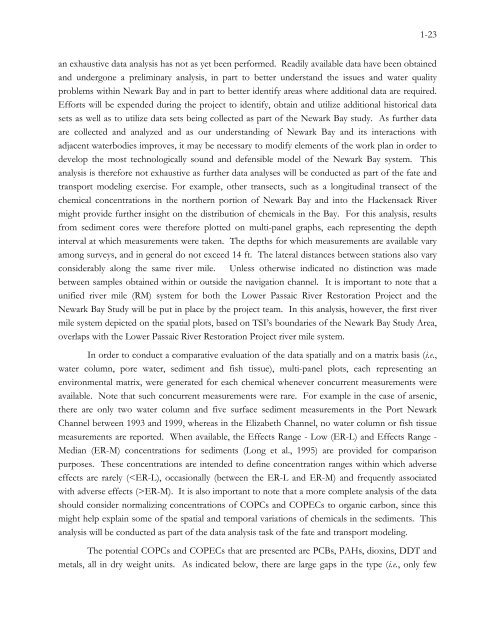Newark Bay Study - Passaic River Public Digital Library
Newark Bay Study - Passaic River Public Digital Library
Newark Bay Study - Passaic River Public Digital Library
Create successful ePaper yourself
Turn your PDF publications into a flip-book with our unique Google optimized e-Paper software.
1-23<br />
an exhaustive data analysis has not as yet been performed. Readily available data have been obtained<br />
and undergone a preliminary analysis, in part to better understand the issues and water quality<br />
problems within <strong>Newark</strong> <strong>Bay</strong> and in part to better identify areas where additional data are required.<br />
Efforts will be expended during the project to identify, obtain and utilize additional historical data<br />
sets as well as to utilize data sets being collected as part of the <strong>Newark</strong> <strong>Bay</strong> study. As further data<br />
are collected and analyzed and as our understanding of <strong>Newark</strong> <strong>Bay</strong> and its interactions with<br />
adjacent waterbodies improves, it may be necessary to modify elements of the work plan in order to<br />
develop the most technologically sound and defensible model of the <strong>Newark</strong> <strong>Bay</strong> system. This<br />
analysis is therefore not exhaustive as further data analyses will be conducted as part of the fate and<br />
transport modeling exercise. For example, other transects, such as a longitudinal transect of the<br />
chemical concentrations in the northern portion of <strong>Newark</strong> <strong>Bay</strong> and into the Hackensack <strong>River</strong><br />
might provide further insight on the distribution of chemicals in the <strong>Bay</strong>. For this analysis, results<br />
from sediment cores were therefore plotted on multi-panel graphs, each representing the depth<br />
interval at which measurements were taken. The depths for which measurements are available vary<br />
among surveys, and in general do not exceed 14 ft. The lateral distances between stations also vary<br />
considerably along the same river mile. Unless otherwise indicated no distinction was made<br />
between samples obtained within or outside the navigation channel. It is important to note that a<br />
unified river mile (RM) system for both the Lower <strong>Passaic</strong> <strong>River</strong> Restoration Project and the<br />
<strong>Newark</strong> <strong>Bay</strong> <strong>Study</strong> will be put in place by the project team. In this analysis, however, the first river<br />
mile system depicted on the spatial plots, based on TSI’s boundaries of the <strong>Newark</strong> <strong>Bay</strong> <strong>Study</strong> Area,<br />
overlaps with the Lower <strong>Passaic</strong> <strong>River</strong> Restoration Project river mile system.<br />
In order to conduct a comparative evaluation of the data spatially and on a matrix basis (i.e.,<br />
water column, pore water, sediment and fish tissue), multi-panel plots, each representing an<br />
environmental matrix, were generated for each chemical whenever concurrent measurements were<br />
available. Note that such concurrent measurements were rare. For example in the case of arsenic,<br />
there are only two water column and five surface sediment measurements in the Port <strong>Newark</strong><br />
Channel between 1993 and 1999, whereas in the Elizabeth Channel, no water column or fish tissue<br />
measurements are reported. When available, the Effects Range - Low (ER-L) and Effects Range -<br />
Median (ER-M) concentrations for sediments (Long et al., 1995) are provided for comparison<br />
purposes. These concentrations are intended to define concentration ranges within which adverse<br />
effects are rarely (ER-M). It is also important to note that a more complete analysis of the data<br />
should consider normalizing concentrations of COPCs and COPECs to organic carbon, since this<br />
might help explain some of the spatial and temporal variations of chemicals in the sediments. This<br />
analysis will be conducted as part of the data analysis task of the fate and transport modeling.<br />
The potential COPCs and COPECs that are presented are PCBs, PAHs, dioxins, DDT and<br />
metals, all in dry weight units. As indicated below, there are large gaps in the type (i.e., only few




